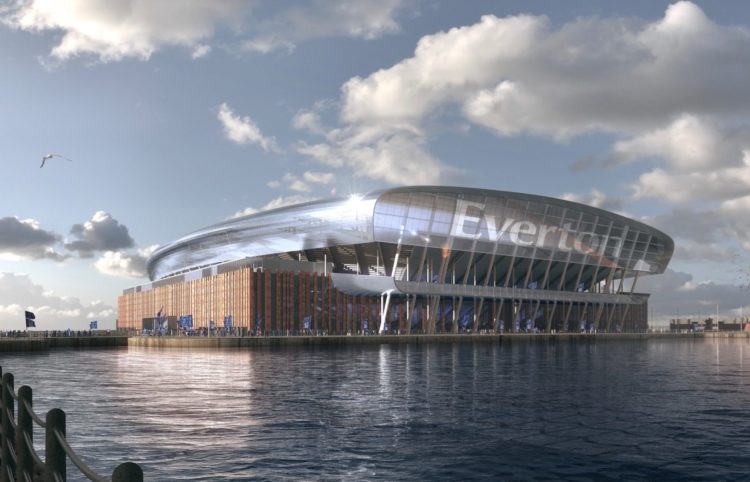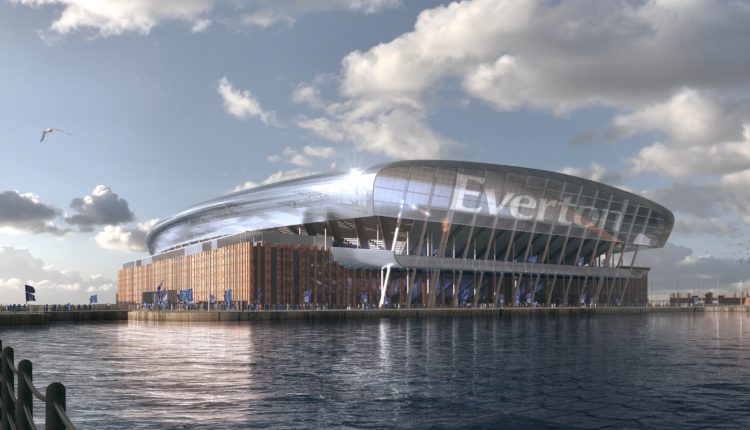With a capacity of 52,000, with the option of rising to 62,000, it is hoped the arena at Bramley Moore Dock in Liverpool Waters will be ready for the 2023-24 season. Tony McDonough reports

Everton Football Club has released the first detailed images of the designs for its proposed new £500m stadium on Liverpool waterfront.
With a capacity of 52,000, with the option of rising to 62,000, it is hoped the arena at Bramley Moore Dock in Liverpool Waters, will be ready in time for the kick-off of the2023-24 Premier League season.
Images of the stadium, which it is claimed will boost the city’s economy by £1bn, were revealed by world-renowned architect Dan Meis at an event for the club’s fans held in a former warehouse at the Titanic Hotel just yards from the proposed location.
Historic and modern
The concepts show a stunning brick, steel and glass design which takes its inspiration from the historic maritime and warehouse buildings nearby.
The structure combines the historic and the modern, with the brick base of the stadium incorporating a subtle nod to Goodison Park’s famous Archibald Leitch lattice work while the dynamic roof structure made from steel and glass gives the stadium a modern finish.
Click to see a video fly-through of the new stadium
It is made up of four distinctive stands including a large steep home stand to the south that will house 13,000 Evertonians on matchdays. Supporters will be as close to the action as regulations permit as the club seeks to capture and amplify the intensity and intimacy of Goodison Park in this modern arena.
The design of both North and South stand lower tiers will make it easy to adopt rail seating and, should legislation change in the future, they could also be converted into areas for safe standing offering supporters optionality and flexibility in the future.
Everton also used the event to reveal its plans for the redevelopment of Goodison Park to create a range of community assets such as homes, health, education and enterprise amenities as well as the introduction of public space which will include a lasting tribute to the club’s current home of 127 years.
Game-changer
Prof Denise Barrett-Baxendale, Everton’s chief executive, said: “Today marks an incredibly important milestone for us as we seek to build a new stadium which will act as a ‘game changer’ for the club and our city region.
“Our proposed stadium design takes its inspiration from both our city’s maritime history and from our Club’s rich heritage and traditions.


“It is, first and foremost, a stadium for football, for our passionate fans and for our players. A stadium that gives Everton FC a platform for growth both commercially and socially. But it is also a stadium for the entire city and a development which will deliver transformative benefits”
The event marked the start of a month-long public consultation into Everton’s plans – which have been badged as The People’s Project – with the results of the consultation informing further refinements to the proposals.
Planning applications
Following the final detailed design work, two planning applications will be submitted: a detailed application for Bramley-Moore Dock and an outline application for Goodison Park. These applications are expected to be submitted before the end of 2019.
Everton’s proposals include extensive, high quality public spaces for use on both matchdays and non-matchdays, the creation of a waterway to connect the docks and a new multi-storey car park next to the river, with a footbridge linking it to the stadium.
The car park would be low enough that it did not block views of the stadium from the river or views of the river from the stadium.
It would be built on a north-south orientation. This is the best approach in terms of the impact of sunshine and shadow on the fans’ experience and on the televising of matches. It is also the best approach with regards to prevailing winds, retention of heritage assets and provision of public space around the stadium.

